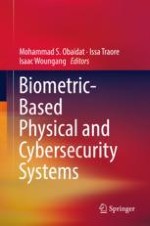2019 | OriginalPaper | Chapter
20. Protecting the Integrity of Elections Using Biometrics
Authors : Mohammad S. Obaidat, Tanmoy Maitra, Debasis Giri
Published in: Biometric-Based Physical and Cybersecurity Systems
Publisher: Springer International Publishing
Activate our intelligent search to find suitable subject content or patents.
Select sections of text to find matching patents with Artificial Intelligence. powered by
Select sections of text to find additional relevant content using AI-assisted search. powered by
